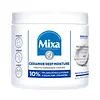What's inside
What's inside
 Key Ingredients
Key Ingredients

 Benefits
Benefits

 Concerns
Concerns

 Ingredients Side-by-side
Ingredients Side-by-side

Water
Skin ConditioningGlycerin
HumectantButyrospermum Parkii Butter
Skin ConditioningIsopropyl Palmitate
EmollientPropanediol
SolventCetyl Alcohol
EmollientMyristyl Myristate
EmollientZea Mays Starch
AbsorbentSqualane
EmollientCarbomer
Emulsion StabilisingSodium Hydroxide
Buffering2-Oleamido-1,3-Octadecanediol
Skin ConditioningHydroxyacetophenone
AntioxidantHydroxypalmitoyl Sphinganine
Skin ConditioningCaprylyl Glycol
EmollientCitric Acid
BufferingPolyglyceryl-3 Methylglucose Distearate
EmulsifyingTocopherol
AntioxidantWater, Glycerin, Butyrospermum Parkii Butter, Isopropyl Palmitate, Propanediol, Cetyl Alcohol, Myristyl Myristate, Zea Mays Starch, Squalane, Carbomer, Sodium Hydroxide, 2-Oleamido-1,3-Octadecanediol, Hydroxyacetophenone, Hydroxypalmitoyl Sphinganine, Caprylyl Glycol, Citric Acid, Polyglyceryl-3 Methylglucose Distearate, Tocopherol
Water
Skin ConditioningButyrospermum Parkii Butter
Skin ConditioningPanthenol
Skin ConditioningCetearyl Alcohol
EmollientSimmondsia Chinensis Seed Oil
EmollientDicaprylyl Ether
EmollientGlycerin
HumectantGlyceryl Stearate
EmollientPrunus Armeniaca Kernel Oil
MaskingC13-15 Alkane
SolventPropanediol
SolventPentylene Glycol
Skin ConditioningCetearyl Olivate
Argania Spinosa Kernel Oil
EmollientDiglycerin
HumectantEctoin
Skin ConditioningCeramide EOP
Skin ConditioningCeramide Ns
Skin ConditioningCeramide NP
Skin ConditioningCeramide As
Skin ConditioningCeramide AP
Skin ConditioningCholesterol
EmollientHydrogenated Lecithin
EmulsifyingSucrose Distearate
EmollientHeterotheca Inuloides Flower Extract
MaskingDipropylene Glycol
HumectantSorbitan Olivate
EmulsifyingSea Water
HumectantLaminaria Digitata Extract
Skin ProtectingChlorella Vulgaris Extract
Skin ConditioningSaccharide Isomerate
HumectantXanthan Gum
EmulsifyingHydroxyacetophenone
AntioxidantPhenoxyethanol
PreservativeEthylhexylglycerin
Skin ConditioningLactic Acid
BufferingCitric Acid
BufferingWater, Butyrospermum Parkii Butter, Panthenol, Cetearyl Alcohol, Simmondsia Chinensis Seed Oil, Dicaprylyl Ether, Glycerin, Glyceryl Stearate, Prunus Armeniaca Kernel Oil, C13-15 Alkane, Propanediol, Pentylene Glycol, Cetearyl Olivate, Argania Spinosa Kernel Oil, Diglycerin, Ectoin, Ceramide EOP, Ceramide Ns, Ceramide NP, Ceramide As, Ceramide AP, Cholesterol, Hydrogenated Lecithin, Sucrose Distearate, Heterotheca Inuloides Flower Extract, Dipropylene Glycol, Sorbitan Olivate, Sea Water, Laminaria Digitata Extract, Chlorella Vulgaris Extract, Saccharide Isomerate, Xanthan Gum, Hydroxyacetophenone, Phenoxyethanol, Ethylhexylglycerin, Lactic Acid, Citric Acid
 Reviews
Reviews

Ingredients Explained
These ingredients are found in both products.
Ingredients higher up in an ingredient list are typically present in a larger amount.
This ingredient is also known as shea butter. It is an effective skin hydrator and emollient.
Emollients help soothe and soften your skin. It does this by creating a protective film on your skin. This barrier helps trap moisture and keeps your skin hydrated. Emollients may be effective at treating dry or itchy skin.
Shea butter is rich in antioxidants. Antioxidants help fight free-radicals, or molecules that may harm the body. It is also full of fatty acids including stearic acid and linoleic acid. These acids help replenish the skin and keep skin moisturized.
While Shea Butter has an SPF rating of about 3-4, it is not a sunscreen replacement.
Shea butter may not be fungal acne safe. We recommend speaking with a professional if you have any concerns.
Learn more about Butyrospermum Parkii ButterCitric Acid is an alpha hydroxy acid (AHA) naturally found in citrus fruits like oranges, lemons, and limes.
Like other AHAs, citric acid can exfoliate skin by breaking down the bonds that hold dead skin cells together. This helps reveal smoother and brighter skin underneath.
However, this exfoliating effect only happens at high concentrations (20%) which can be hard to find in cosmetic products.
Due to this, citric acid is usually included in small amounts as a pH adjuster. This helps keep products slightly more acidic and compatible with skin's natural pH.
In skincare formulas, citric acid can:
While it can provide some skin benefits, research shows lactic acid and glycolic acid are generally more effective and less irritating exfoliants.
Most citric acid used in skincare today is made by fermenting sugars (usually from molasses). This synthetic version is identical to the natural citrus form but easier to stabilize and use in formulations.
Read more about some other popular AHA's here:
Learn more about Citric AcidGlycerin is already naturally found in your skin. It helps moisturize and protect your skin.
A study from 2016 found glycerin to be more effective as a humectant than AHAs and hyaluronic acid.
As a humectant, it helps the skin stay hydrated by pulling moisture to your skin. The low molecular weight of glycerin allows it to pull moisture into the deeper layers of your skin.
Hydrated skin improves your skin barrier; Your skin barrier helps protect against irritants and bacteria.
Glycerin has also been found to have antimicrobial and antiviral properties. Due to these properties, glycerin is often used in wound and burn treatments.
In cosmetics, glycerin is usually derived from plants such as soybean or palm. However, it can also be sourced from animals, such as tallow or animal fat.
This ingredient is organic, colorless, odorless, and non-toxic.
Glycerin is the name for this ingredient in American English. British English uses Glycerol/Glycerine.
Learn more about GlycerinHydroxyacetophenone is antioxidant with skin conditioning and soothing properties. It also boosts the efficiency of preservatives.
This ingredient is not irritating or sensitizing.
Propanediol is an all-star ingredient. It softens, hydrates, and smooths the skin.
It’s often used to:
Propanediol is not likely to cause sensitivity and considered safe to use. It is derived from corn or petroleum with a clear color and no scent.
Learn more about PropanediolWater. It's the most common cosmetic ingredient of all. You'll usually see it at the top of ingredient lists, meaning that it makes up the largest part of the product.
So why is it so popular? Water most often acts as a solvent - this means that it helps dissolve other ingredients into the formulation.
You'll also recognize water as that liquid we all need to stay alive. If you see this, drink a glass of water. Stay hydrated!
Learn more about Water